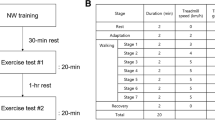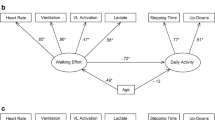Abstract
Moderate-intensity physical activity is recommended to promote health, and augment peak oxygen transport, thus reducing the risk of chronic disease, and delaying functional loss in the elderly. The optimal method of prescribing the recommended intensity of effort [approximately 50% of oxygen intake reserve (V̇O2reserve) or heart rate reserve (HRreserve)] remains unclear for this age group. Our aim was to develop a new field-method of prescribing exercise for the elderly, based on walking velocity measured over a 5-m distance. Walking velocities were calculated from the time taken to move from the 3-m to the 8-m mark on an 11-m, straight, flat walkway. Interrelationships of preferred and maximal walking velocities with traditional laboratory measurements [peak isometric knee-extension strength and maximal oxygen intake (V̇O2max)] were examined in 10 healthy male and 13 healthy female volunteers, aged 65–74 years. Percentages of oxygen intake reserve (%V̇O2reserve) and heart rate reserve (%HRreserve) were also determined when walking at 30–70% of maximal velocity. Preferred and maximal walking velocities were significantly correlated (r>0.60; P<0.05), the former corresponding to an average of 53–54% of the latter in both men and women. Maximal walking velocity was significantly correlated with both peak knee-extension torque (r>0.90; P<0.05) and V̇O2max (r>0.80; P<0.05). As a result, the %V̇O2reserve and %HRreserve showed a regular and linear relationship to various submaximal walking velocities. For both men and women, 40–60% of the maximal walking velocity corresponded to about 30–50% of V̇O2reserve and HRreserve. Approximately 60% of the maximal walking velocity (or 110–115% of the preferred walking velocity) represents an appropriate intensity of moderate exercise for the typical elderly person. Our preliminary data suggest that a prescription based on walking velocity over the 5-m distance allows the healthy elderly to exercise simply, safely, and effectively.


Similar content being viewed by others
References
American College of Sports Medicine (1998a) Position stand: The recommended quantity and quality of exercise for developing and maintaining cardiorespiratory and muscular fitness, and flexibility in healthy adults. Med Sci Sports Exerc 30:975–991
American College of Sports Medicine (1998b) Position stand: Exercise and physical activity for older adults. Med Sci Sports Exerc 30:992–1008
Aoyagi Y (1996) Endurance training, heat acclimation, and protective clothing: the thermophysiology of exercising in a hot climate. Dissertation, University of Toronto, Canada
Aoyagi Y, Katsuta S (1990) Relationship between the starting age of training and physical fitness in old age. Can J Sport Sci 15:65–71
Aoyagi Y, Shephard RJ (1992) Aging and muscle function. Sports Med 14:376–396
Aoyagi Y, McLellan TM, Shephard RJ (1997) Interactions of physical training and heat acclimation: the thermophysiology of exercising in a hot climate. Sports Med 23:173–210
Blair SN, Kampert JB, Kohl HW III, Barlow CE, Macera CA, Paffenbarger RS Jr, Gibbons LW (1996) Influences of cardiorespiratory fitness and other precursors on cardiovascular disease and all-cause mortality in men and women. JAMA 276:205–210
Church TS, Kampert JB, Gibbons LW, Barlow CE, Blair SN (2001) Usefulness of cardiorespiratory fitness as a predictor of all-cause and cardiovascular disease mortality in men with systemic hypertension. Am J Cardiol 88:651–656
Fiatarone MA, O’Neill EF, Ryan ND, Clements KM, Solares GR, Nelson ME, Roberts SB, Kehayias JJ, Lipsitz LA, Evans WJ (1994) Exercise training and nutritional supplementation for physical frailty in very elderly people. N Engl J Med 330:1769–1775
Guralnik JM, Ferrucci L, Simonsick EM, Salive ME, Wallace RB (1995) Lower-extremity function in persons over the age of 70 years as a predictor of subsequent disability. N Engl J Med 332:556–561
Guralnik JM, Ferrucci L, Pieper CF, Leveille SG, Markides KS, Ostir GV, Studenski S, Berkman LF, Wallace RB (2000) Lower extremity function and subsequent disability: consistency across studies, predictive models, and value of gait speed alone compared with the short physical performance battery. J Gerontol A Biol Sci Med Sci 55:M221–M231
Hageman PA, Thomas VS (2002) Gait performance in dementia: the effects of a 6-week resistance training program in an adult day-care setting. Int J Geriatr Psychiatry 17:329–334
Kurl S, Laukkanen JA, Rauramaa R, Lakka TA, Sivenius J, Salonen JT (2003) Cardiorespiratory fitness and the risk for stroke in men. Arch Intern Med 163:1682–1688
LaMonte MJ, Eisenman PA, Adams TD, Shultz BB, Ainsworth BE, Yanowitz FG (2000) Cardiorespiratory fitness and coronary heart disease risk factors: the LDS Hospital Fitness Institute cohort. Circulation 102:1623–1628
Laukkanen JA, Lakka TA, Rauramaa R, Kuhanen R, Venalainen JM, Salonen R, Salonen JT (2001) Cardiovascular fitness as a predictor of mortality in men. Arch Intern Med 161:825–831
Lee CD, Blair SN (2002a) Cardiorespiratory fitness and stroke mortality in men. Med Sci Sports Exerc 34:592–595
Lee CD, Blair SN (2002b) Cardiorespiratory fitness and smoking-related and total cancer mortality in men. Med Sci Sports Exerc 34:735–739
Mazzeo RS, Tanaka H (2001) Exercise prescription for the elderly: current recommendations. Sports Med 31:809–818
McArdle WD, Katch FI, Katch VL (1991) Exercise physiology: energy, nutrition, and human performance, 3rd edn. Lea & Febiger, Philadelphia, Pa.
Nagasaki H, Itoh H, Furuna T (1995a) A physical fitness model of older adults. Aging Clin Exp Res 7:392–397
Nagasaki H, Itoh H, Furuna T (1995b) The structure underlying physical performance measures for older adults in the community. Aging Clin Exp Res 7:451–458
Nelson ME, Fiatarone MA, Morganti CM, Trice I, Greenberg RA, Evans WJ (1994) Effects of high-intensity strength training on multiple risk factors for osteoporotic fractures: a randomized controlled trial. JAMA 272:1909–1914
Oliveria SA, Kohl HW III, Trichopoulos D, Blair SN (1996) The association between cardiorespiratory fitness and prostate cancer. Med Sci Sports Exerc 28:97–104
Ostir GV, Markides KS, Black SA, Goodwin JS (1998) Lower body functioning as a predictor of subsequent disability among older Mexican Americans. J Gerontol A Biol Sci Med Sci 53:M491–M495
Penninx BW, Ferrucci L, Leveille SG, Rantanen T, Pahor M, Guralnik JM (2000) Lower extremity performance in nondisabled older persons as a predictor of subsequent hospitalization. J Gerontol A Biol Sci Med Sci 55:M691–M697
Shephard RJ (1997) Aging, physical activity, and health. Human Kinetics, Champaign, Ill.
Shinkai S, Watanabe S, Kumagai S, Fujiwara Y, Amano H, Yoshida H, Ishizaki T, Yukawa H, Suzuki T, Shibata H (2000) Walking speed as a good predictor for the onset of functional dependence in a Japanese rural community population. Age Ageing 29:441–446
Wei M, Gibbons LW, Mitchell TL, Kampert JB, Lee CD, Blair SN (1999a) The association between cardiorespiratory fitness and impaired fasting glucose and type 2 diabetes mellitus in men. Ann Intern Med 130:89–96
Wei M, Kampert JB, Barlow CE, Nichaman MZ, Gibbons LW, Paffenbarger RS Jr, Blair SN (1999b) Relationship between low cardiorespiratory fitness and mortality in normal-weight, overweight, and obese men. JAMA 282:1547–1553
Wei M, Gibbons LW, Kampert JB, Nichaman MZ, Blair SN (2000) Low cardiorespiratory fitness and physical inactivity as predictors of mortality in men with type 2 diabetes. Ann Intern Med 132:605–611
Woo J, Ho SC, Yu AL (1999) Walking speed and stride length predict 36 months dependency, mortality, and institutionalization in Chinese aged 70 and older. J Am Geriatr Soc 47:1257–1260
Acknowledgements
This research was undertaken as part of the longitudinal, interdisciplinary study on physical activity and health of the elderly in Nakanojo, Gunma, Japan (the Nakanojo Study). The study was supported in part by grants from the Meiji Life Foundation of Health and Welfare, the Nakatomi Foundation, and the Japan Society for the Promotion of Science. The authors gratefully acknowledge the expert technical assistance of the research and nursing staffs of the Tokyo Metropolitan Institute of Gerontology and the Tokyo Metropolitan Health Promotion Center. We would also like to thank the subjects whose participation made this investigation possible.
Author information
Authors and Affiliations
Corresponding author
Rights and permissions
About this article
Cite this article
Aoyagi, Y., Togo, F., Matsuki, S. et al. Walking velocity measured over 5 m as a basis of exercise prescription for the elderly: preliminary data from the Nakanojo Study. Eur J Appl Physiol 93, 217–223 (2004). https://doi.org/10.1007/s00421-004-1202-6
Accepted:
Published:
Issue Date:
DOI: https://doi.org/10.1007/s00421-004-1202-6




